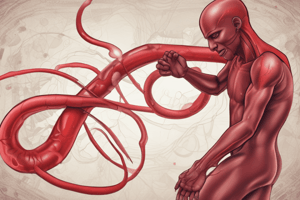Podcast
Questions and Answers
Match the following blood cell disorder with its description:
Match the following blood cell disorder with its description:
Thalassemias = Defective production and assembly of globin chains affecting hemoglobin molecules Autoimmune hemolytic anemia = Antibodies attacking RBCs prematurely shortening their lifespan Leukopenia = Low white blood cell count Thrombocytopenia = Decreased platelet counts leading to increased bleeding tendency
Match the following white blood cell type with its function:
Match the following white blood cell type with its function:
Neutrophils = Recognizing and killing foreign pathogens through phagocytosis Lymphocytes = Activating specific immune responses Basophils = Secreting antimicrobial proteins Monocytes = Playing crucial roles in fighting off infections
Match the following condition with its effect on white blood cells:
Match the following condition with its effect on white blood cells:
Neutropenia = Lowering the number of neutrophils increasing susceptibility to bacterial infections Leukocytosis = Indicating high numbers of WBCs often as a response to infection or inflammation Leukopenia = Referring to a low white blood cell count Excessive production of mature white blood cells = A potential cause of leukocytosis
Match the following platelet disorder with its outcome:
Match the following platelet disorder with its outcome:
Match the following statement with the correct conclusion:
Match the following statement with the correct conclusion:
Flashcards are hidden until you start studying
Study Notes
Exploring Hematology's Focus on Blood Cell Disorders
Hematology is the scientific discipline that studies all aspects of blood, including its composition, function, diseases, and treatments. A significant portion of hematologists' work revolves around understanding and managing various blood cell disorders. These conditions can affect red blood cells (RBC), white blood cells (WBC), platelets, and the specialized cells found within our bone marrow – called stem cells – which give rise to these elements. Let's delve into some common blood cell disorders and their critical roles in human health.
Red Blood Cells
Red blood cells contain hemoglobin, a protein responsible for transporting oxygen from the lungs to other body tissues while carrying carbon dioxide back to the lungs for expiration. Anemia occurs when RBC counts decrease, leading to fatigue because less oxygen reaches cells due to fewer working RBCs. Common causes of anemia include iron deficiency anemia, vitamin B12 deficiency anemia, sickle cell disease, thalassemias, and autoimmune hemolytic anemia.
Sickle cell disease is an inherited condition where abnormal shape deformities cause damaged red blood cells. They often become stuck in small blood vessels, blocking the flow of healthy blood and causing severe pain crises. Sickle cell crisis is one example of how dysfunctional RBCs lead to debilitating symptoms.
Thalassemias involve defective production and assembly of the globin chains that make up hemoglobin molecules. Hemoglobin abnormalities disrupt normal RBC functions like delivering oxygen throughout the body, creating chronic anemic states.
Autoimmune hemolytic anemia arises when antibodies attack RBCs prematurely ending their lifespan. This disorder leads to increased destruction of RBCs, resulting in reduced levels circulating throughout the bloodstream.
White Blood Cells
White blood cells play crucial roles in fighting off infections by recognizing and killing foreign pathogens through processes such as phagocytosis, secreting antimicrobial proteins, and activating specific immune responses. Neutrophils, lymphocytes, monocytes, basophils, and eosinophils represent the five main types of WBCs. Leukopenia refers to low white blood cell count, whereas leukocytosis indicates high numbers of WBCs. Conditions like neutropenia lower the number of neutrophils, increasing susceptibility to bacterial infections. On the contrary, leukocytosis may signal a response to infection or inflammation, sometimes caused by excessive production of mature white blood cells.
Platelets
Platelets are essential components of blood clot formation, preventing bleeding after injury. Thrombocytopenia results from decreased platelet counts, making individuals more prone to bruising or experiencing prolonged bleeding due to impaired blood clotting ability. An increase in platelet levels, known as thrombocytosis, suggests potential underlying conditions like cancer, infection, or after surgery, though it does not always mean there's something wrong.
Conclusion
Blood cell disorders encompass a wide range of complex problems affecting humans in varying ways. Researchers diligently study these issues to develop new diagnostic tools, improve existing therapies, identify biological mechanisms behind these conditions, and discover innovative treatment strategies. Understanding hematological disorders is key to improving patient care and quality of life.
Studying That Suits You
Use AI to generate personalized quizzes and flashcards to suit your learning preferences.




